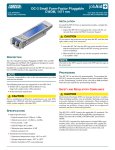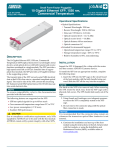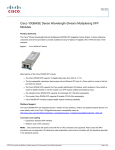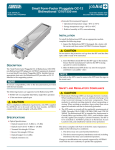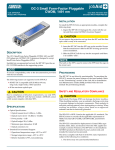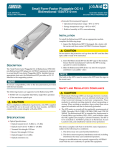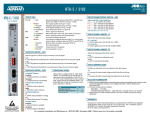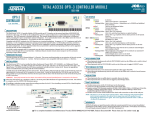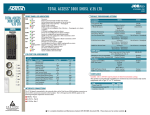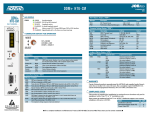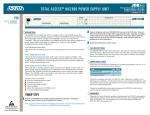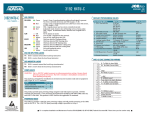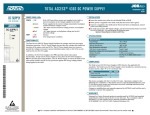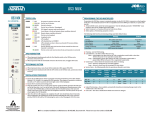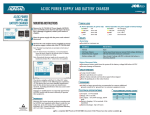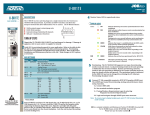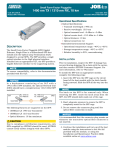Download Adtran XFP 10G 1550nm
Transcript
jobAid Small Form-Factor Pluggable CLEI: BVL3AGKD_ _ Product P/N: 1442980G1C 10 Gigabit Ethernet XFP, 1550 nm Commercial Temperature Issue Date: 0909 Document P/N: 61442980G1C-22A ◊ Optical receive level: greater than –24dBm ◊ Optical distance: 80 km maximum ◊ Optical connectors: LC ♦ Extended Environmental Support: ◊ Operational temperature range: 0°C to +70°C ◊ Storage temperature range: –40°C to +85°C ◊ Relative humidity to 85%, noncondensing INSTALLATION Inspect the XFP. If damaged, file a claim with the carrier and then contact ADTRAN Customer Service. DESCRIPTION The Small Form‐Factor Pluggable 10 Gigabit Ethernet XFP, 1550 nm, Commercial Temperature (XFP) optical transceiver is a fully duplex serial electric, serial optic device with both transmit and receive functions contained in a single module that provides a high speed serial link at 10 Gb/s. Installed into an appropriate host module, the XFP provides a 10 Gigabit interface to the supporting system. The transmit side of the XFP converts serial NRZ electrical date at the10 Gb/s line rate to a standard compliant optical signal. The receive side of the XFP converts the incoming DC balanced serial NRZ optical data at the 10 Gb/s line rate into serial electrical data. NOTE To ensure compatibility, refer to the documentation provided with the host module. The following features are supported on the XFP: ♦ 1550 nm optical signals for up to 80 km reach ♦ Low power consumption (<3.5 W max) ♦ Excellent EMI performance ♦ Bit error rate 10^‐12 ! CAUTION Due to compliance certification requirements, only XFPs supplied by ADTRAN are to be used with the host module. ADTRAN cannot certify system integrity with other XFPs. Operational Specifications ♦ Optical Specifications: ◊ Transmit Wavelength: 1550 nm ◊ Receive Wavelength: 1530 to 1565 nm ◊ Data rate: 9.95 Gb/s to 11.1 Gb/s ◊ Optical transmit level: 0 to +4.0 dBm To install the XFP into an appropriate module, complete the following steps: 1. Insert the XFP into the XFP cage on the circuit board of the host module with the latch handle facing outward. Slide the XFP all the way into the receptacle. NOTE The latch on the XFP is for removal only. When removing the XFP, rotate the latch away from the XFP cage until a physical click occurs. The XFP should slide easily out of the cage. 2. Using thumb and forefinger, exert adequate pressure to ensure the XFP is completely seated in the XFP cage. 3. Do not remove the connector plug until the optical fiber connection is made. NOTICE It is recommended that the connector plug remain on whenever the transceiver optical fiber connector is not inserted. 4. Continue the installation and turn‐up of the host module using the instructions in the Job Aid provided with that module, or using the Installation and Maintenance Practice (I&M), available online at www.adtran.com. PROVISIONING The XFP is not directly provisionable. To provision the XFP, access the menu system of the host module. Refer to the “Provi‐ sioning” section of the Job Aid or Installation and Maintenance Practice provided with the host module for provisioning details. COMPLIANCE ! CAUTION ♦ Electrostatic Discharge (ESD) can damage electronic modules. When handling modules, wear an antistatic discharge wrist strap to prevent damage to electronic components. Place modules in antistatic packing material when transporting or storing. When working on modules, always place them on an approved antistatic mat that is electrically grounded. ♦ The XFP meets or exceeds all the applicable requirements of NEBS, Telcordia GR‐63‐CORE, and GR‐1089‐CORE. The XFP is intended for deployment in Central Office type facilities, EEEs, EECs, and locations where the NEC applies (for example, Customer Premises). The XFP is to be installed in ADTRAN products in Restricted Access Locations only, and installed by trained service personnel. NOTE The Gigabit Ethernet port(s) are optical and therefore are not classified as any type of port as defined in Appendix B of GR‐ 1089‐CORE Issue 4. The XFP is designed to meet the following environmental classes: ♦ ETSI EN 300 019‐1‐1 “Classification of environmental conditions; Storage,” Class 1.2 ♦ ETSI EN 300 019‐1‐2 “Classification of environmental conditions, Transportation,” Class 2.3 ♦ ETSI EN 300 019‐1‐3 “Classification of environmental conditions, Stationary use at weather‐protected locations,” Class 3.3 The equipment is designed to function without degradation during exposure to all test severities per Class 3.3. This device complies with FCC 47 CFR Part 15, Class B. Operation is subject to the following two conditions: 1. This device may not cause harmful interference. 2. This device must accept any interference received, including interference that may cause undesired operation. Changes or modifications not expressly approved by ADTRAN could void the userʹs authority to operate this equipment. ♦ Per GR‐1089‐CORE, the ADTRAN system in which the SFP is being deployed is designed and intended for installation as part of a Common Bonding Network (CBN). The ADTRAN system in which the SFP is being deployed is not designed nor intended for installation as part of an Isolated Bonding Network (IBN). ♦ Per GR‐1089‐CORE Section 9, the XFP does not have an internal DC connection between battery return and frame ground. The XFP can be installed in a DC‐I (isolated) or DC‐C (common) installation. For installations where other cards or the host system have internal connections between battery return and frame ground, the system would be intended for deployment only in a DC‐C installation. ♦ The ADTRAN system chassis frame ground terminal must be connected to a reliable earth ground to ensure that the metal enclosure of the XFP is properly grounded via the backplane connector. C CAUTION The XFP is a Class 1 Laser Product and complies with the Laser Safety requirements of FDA 21CFR 1040.10 and 1040.11, and EN60825‐1 and ‐2. The XFP is NRTL listed and CB Certified to all applicable American and European safety standards. For continued compliance with the above laser safety standards, only approved Class 1 modules from our approved vendor list, located on the ADTRAN website, should be installed in ADTRAN products. For more information, refer to the Installation and Maintenance Practice (P/N 61442980G1C-5) available online at www.adtran.com. Warranty: ADTRAN will replace or repair this product within the warranty period if it does not meet its published specifications or fails while in service. Warranty information can be found online at www.adtran.com/warranty. ©2009 ADTRAN, Inc. All Rights Reserved. PRICING AND AVAILABILITY 800.827.0807 TECHNICAL SUPPORT 800.726.8663 RETURN FOR REPAIR 256.963.8722 CAUTION! SUBJECT TO ELECTROSTATIC DAMAGE OR DECREASE IN RELIABILITY. HANDLING PRECAUTIONS REQUIRED. *61442980G1C-22A*


